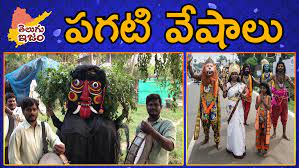Pagati Veshalu : Daywear , A Popular & Historical Folk Art
Pagati Veshalu : Also known as Daywear, A form of folk art that is performed during the daytime. It is characterized by performers wearing various disguises and costumes and is known solely by the time of its performance.
Street plays or street dramas are popular forms of folk art, and researchers suggest that street dramas have become a form of daytime entertainment. Depending on the time of the performance, they are referred to as Pagati Veshalu. These performances take place only during the day.
Pagati Veshalu can be further categorized into different types, such as daywear, nomadic daywear, and local daywear. Nomadic daywear performers travel and perform extensively. They are also known as polymorphous. Daytime performances in a village can last for months, with each day featuring a different performance until the culmination on the final day.
Unfortunately, many folk arts, including Pagati Veshalu, have experienced a decline in popularity and have turned into a begging profession. However, those who appreciate the art form and understand its significance still support the performers by providing sambhavana, a form of financial support. The performers take care of grooming and decoration, and they make the dialogues and poems interesting to engage the audience.
Over time, there have been changes in the costumes and characters of Pagati Veshalu. Some characters that were once performed, such as the character of Bodi Bapanamma (Widow Brahmin lady), are no longer portrayed. This change is attributed to societal shifts and people’s preferences.
Certain costumes specific to castes and religions, like the Sattani dress and Brahmin dress, may not be worn. However, the Arthanariswara vesham, where a person portrays both male and female characters, is unique among the veshas (disguises) performed in Pagati Veshalu . The makeup for this vesham takes around three hours to apply, and special colors are used to ensure that the makeup lasts until the evening.
In Pagati Veshalu, it is not uncommon for the same performer to speak in the guise of both a man and a woman, showcasing the versatility and artistic skills of the performers.
Pagati Veshalu & It’s History
It can be traced back to various popular stories and the reigns of kings such as King Kalinga Gangukatha, Sambeta King Gurava, and the kings of Vijayanagara. It is believed that this art form has existed since the time of the Satavahanas and is mentioned in the Gathasaptasati of Haluni. Pagati Veshalu embodies qualities from various literary traditions like Marga, Desi, and Sishtha Sahitya.
Originally, there were around 64 different Pagati Veshas, but today, only 32 Veshas are commonly performed. Pagati Veshas can be classified based on different themes. Some of the classifications include religious Veshas like Adibairagi Vesham, Chattadi Vaishnava Vesham, Kommu Dasari Vesham, Haridasu Vesham, Fakir’s disguise, and Saheb’s Vesham. There are also caste-based Veshas like Budabukkala Vesham, Somayajulu – Somidevamma Vesham, Bodi Brahmin Feminine Vesham, Veerabahu Vesham, Gollaboidu Vesham, Koya Vesham, Devarashetti Vesham, and Devangu Vesham.
Mythological Veshas include Jangam Devara Vesham, Shakti or Surpanakha Vesha, and Arthanariswara Vesha. Animal performances include Gangireddula Vesham and Pamulolla Vesham, among others. There are also other types of Veshas such as Pittaladora Vesham, Chitti Pantulu Vesham, and Katikavilla Vesham.
In the performances of Pagati Veshalu, different modes of performance are employed. Some emphasize dialogues, while others focus on poetry, footwork, and the use of musical instruments. Instruments like the harmonium and tabla are used in Purana Veshas, which are performed in the style of Yakshagana. The caste-related day wears satirize the way of life of various castes in the community, criticizing societal views associated with each caste.
Satire is a significant aspect of Pagati Veshalu. There is no specific stage for the performances; they take place in porches, streets, alleys, and corners – wherever the performers find an audience. During the performances, there is no distinction between the audience and the performers. Arthanariswara Vesham is a particularly skilled and proficient Vesham, where a person ties a curtain in the middle and performs as Parvati on one side and Shiva on the other side. By changing the curtain, the audience gets the illusion of seeing either Lord Shiva or Parvati, depending on the side they look from.
The greatness of Pagati Veshalu lies in their ability to trust others. It is believed that these shows were primarily promoted to bring people’s problems to the attention of rulers in the past. Pagalesigas, as they are called in the Rayalaseema region, are akin to Vipra entertainers. They dress up as noble individuals, noblemen, Brahmin widows, etc., and entertain people with their witty speeches. The way they walk, their accent, and their pronunciation are all part of the education they receive to portray the characters authentically.
The performers themselves provide natural and decorative materials for the makeup of each disguise, and they respond to anything said to them with mockery, adding to the satirical nature of the performances.
Also Read : Kolatam : Indeed A Popular & Traditional Team Game

